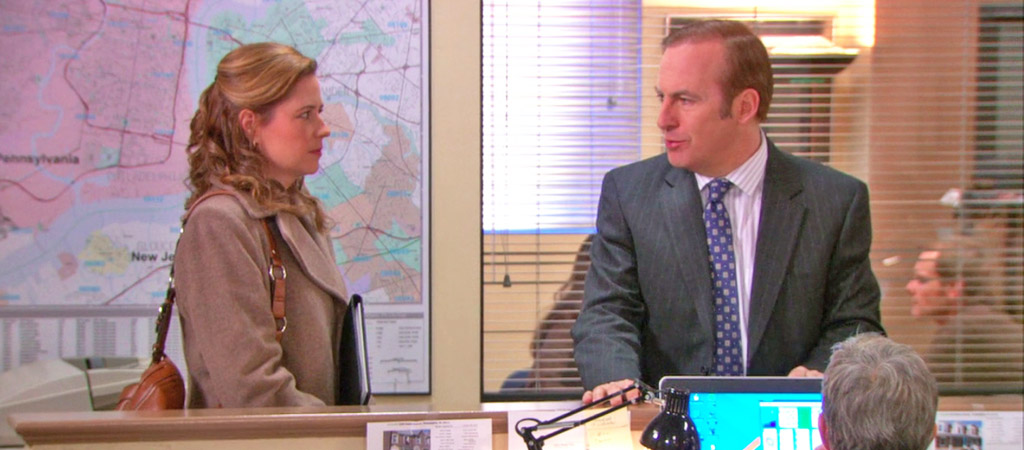
In “Moving On,” the 16th episode of the final season of The Office, Pam interviews for a new job in Philadelphia, only to discover that her would-be boss, played by Bob Odenkirk, is essentially a bizarro Michael Scott. She declines the job because she realizes that she cannot work for another Michael Scott again.
In one way, that episode of The Office comes full circle for Better Call Saul‘s Bob Odenkirk, with him playing a version of the character for which he was very nearly hired back in 2005. The hiring of Michael Scott on The Office, in fact, was probably the most difficult casting decision that had to be made on the show for legendary casting director Allison Jones.
Casting Michael Scott was “the longest part of the [casting] process,” The Office producer Ben Silverman said in Andy Green’s book, The Office: The Untold Story of the Greatest Sitcom of the 2000s. “We were circling Bob Odenkirk. He was available. He had a great reputation in the comedy world, and he hadn’t yet become famous. He wasn’t really well known.”
However, Odenkirk wasn’t the only actor on their radar. In fact, over 35 actors were at least under consideration for the role of Michael Scott, including Robert Townsend, David Arquette, Jason Lee, Dave Foley, Dan Castellaneta, Thomas Lennon, Mark McKinney, Horatio Sanz, Ben Falcone, Owen Wilson, David Koechner, Hank Azaria, Rick Moranis, Kevin Nealon, Dan Aykroyd, Jon Favreau, Eugene Levy, Christopher Guest, Jason Segal, Andy Richter, Jeff Garlin, Cedric the Entertainer, Richard Kind, Matthew Broderick, William H. Macy, Paul F. Tompkins, Stanley Tucci, Steve Buscemi, Gary Cole, Stephen Colbert and John C. Reilly. Most of those actors obviously did not make it past the “consideration stage.” However, Paul Giamatti and Phillip Seymour Hoffman were offered the role, but both declined, Louis C.K. came in and read, but he was barred from starring on The Office because of a holding deal with CBS.
Ultimately, the field was narrowed down to two names: Steve Carell and Bob Odenkirk. They wanted someone with a sort of “generic Americana” feeling, along the lines of Jerry Seinfeld or Tim Allen. They liked The Daily Show alum Steve Carell because of his work on Jim Carrey’s Bruce Almighty. However, Carell was on another NBC show at the time called Come to Papa as the fourth lead, and NBC — which also owned Papa — would not let The Office connect with Carell until the show was officially canceled.
Meanwhile, Bob Odenkirk “really wanted the part,” and “had a great take on the character.” The problem with Odenkirk — which is also what eventually made him so perfect for the role of Saul Goodman — is that “he had an edge to him. His take was as funny as Steve’s, but it was darker,” according to Allison Jones.
He wasn’t “soft” or “likable enough,” according to Silverman. “He was a little tougher and meaner.” Still, as Jones noted, “how often do you have two people as good as Bob Odenkirk and Steve Carell testing for the same role?”
The decision to go with Carell, however, came down to the fact that he was more of a “jerk and a douche,” while Odenkirk was closer to an “asshole.” Carell wasn’t very threatening, which they felt would work better with an American audience.
“The worst thing I have ever had to do ever,” Allison Jones remarked in Andy Greene book, “is to tell Bob Odenkirk’s agent that he didn’t get The Office … Believe me, it was a bummer to make that call and I do suspect the show would have worked with Bob Odenkirk.”
Of course, while Odenkirk did not land that role, he’s doing just fine for himself, approaching the final season of Better Call Saul after several successful seasons on Breaking Bad. Meanwhile, Carell and Odenkirk have 10 Emmy nominations between them, and both can boast about starring in some of the most popular and critically acclaimed television shows of the 2000s. Not bad for two actors who were not very well known in 2004.
Source: The Office: The Untold Story of the Greatest Sitcom of the 2000s
